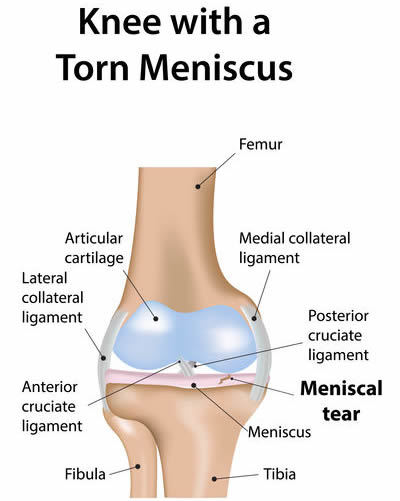Meniscal Tears
 Your knee has twomenisci that sit within the knee joint, between the femur (thigh bone) at the top and the tibia (shin bone) at the bottom. The lateral meniscus is towards the outside of the knee and the medial meniscus is towards the inside. The menisci are made of rubbery cartilage and act like shock-absorbers, cushioning the knee joint and providing additional stability.
Your knee has twomenisci that sit within the knee joint, between the femur (thigh bone) at the top and the tibia (shin bone) at the bottom. The lateral meniscus is towards the outside of the knee and the medial meniscus is towards the inside. The menisci are made of rubbery cartilage and act like shock-absorbers, cushioning the knee joint and providing additional stability.
Damage to the meniscus is often called a meniscal tear. The tear might happen suddenly as the result of an injury, or it may develop slowly over time as the meniscus weakens with age. People with a meniscal tear might experience pain and swelling, catching or locking of the knee or in some cases, the knee might give way during weightbearing.
Non-surgical treatment of a meniscal tear might include:
- rest and activity modification
- medications such as non-steroidal anti-inflammatories (NSAIDS)
- Injections into the knee that help with inflammation
- physiotherapy to strengthen the muscles around the knee
Your surgeon may recommend surgery to treat your meniscal tear if:
- A torn bit of meniscus is catching or locking in the joint
- there are concurrent injuries to other knee structures that cause the knee to be unstable
- the knee becomes “locked” as a result of the meniscus getting jammed in the joint
- non-surgical treatments have been tried but you have ongoing symptoms from your meniscal tear
Sometimes the meniscus can be repaired with sutures. This is usually only done when the surgeon thinks there is a good blood supply to the torn part and it has a good chance of healing. It can be hard to get a meniscus to heal because some parts of the meniscus don’t get nutrients from blood, but gets it from the fluid in the knee. For a repair to heal it needs a blood supply at the healing site.
Sometimes the torn part of the meniscus which is causing symptoms is simply removed (partial menisectomy). The surgeon will take the torn fragment away and leave the stable healthy meniscus in place.
A meniscus tear that occurs in a knee with signs of arthritis is not usually treated with surgery. In these cases (even though the patient has sustained the tear as a result of trauma) the tear has occurred because the meniscus is old and dry and frail. These tears are usually left to settle down and the symptoms are treated with activity modification, pain relief and sometimes injections.
